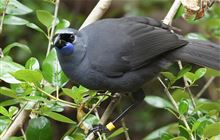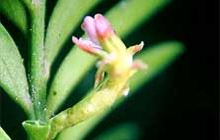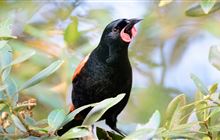Success at Mokaihaha
Archived content: This media release was accurate on the date of publication.
Introduction
Last year's aerial 1080 operation at Mokaihaha Ecological Area has helped enable native bird populations to grow, including a special population of kōkako.Date: 20 February 2019
The aerial 1080 operation at Mokaihaha Ecological Area in September last year has achieved a result that will be of immense benefit to native species this breeding season. Monitoring of introduced rats using tracking tunnels following the aerial 1080 operation last year has shown a huge decline from a rat tracking rate of 37% to 0%.
Biodiversity Ranger Maurice Wilke explained that research has shown that a rat tracking index above 5% means that kōkako and other susceptible birds will have a poor breeding season, as most eggs and chicks will be eaten by rats. A 37% index (i.e. 37 tunnels out of every 100 tunnels showed rat tracks) before the breeding season had even started, would have almost certainly meant a complete loss of kōkako nests this year if pest control had not occurred.
“We know that if kōkako are to have a chance of successfully breeding, rat numbers need to be at 1% or below in early November” he said. “We were hoping to achieve near zero, and this result will enable our important bird populations to continue to thrive. The reason we have treated just over 2000ha is to give kōkako and other species that live outside the core bait station area the opportunity to nest successfully” says Wilke.
“The success of previous pest control programmes has enabled the endemic kōkako to prosper at Mokaihaha” says Jeff Milham, Operation’s Manager. “These endemic birds are not found anywhere else in the world and are considered taonga. This population of kōkako is extra special because these are remnants of the original birds of the area. There are only 11 original kōkako populations now left in New Zealand, and Mokaihaha is amongst the 5 most genetically diverse of these populations.”
Other native birds such as North Island robin, North Island kākā, tūī, bellbird and whiteheads will also breed prolifically. A nesting kākā was observed within the reserve soon after the aerial drop last year. Native bats also occur here and should also benefit from the low pest numbers. Rimu are fruiting heavily this year and without pests competing for food, the intermittent breeder’s such as kākā and kererū will stand a better chance of rearing young. With such low pest levels at Mokaihaha, both species can also be expected to have a highly productive breeding season.
A 2015 survey of adult kōkako established population and distribution within Mokaihaha. This survey recorded 91 adult birds including 39 pairs. A repeat survey in 2018 showed an increase in birds to 94 kōkako including 43 pairs.
The 2018 report showed a greater increase in the number of territorial kōkako may have been expected over the three year period since the 2015 survey.
The report shows kōkako are expanding their territories into a wider area of the Mokaihaha reserve, with the highest number of territories outside the core block as a result of the wider predator control area we have achieved using aerial 1080. The 2018 survey also recorded 13 juvenile birds that are not counted in the adult survey method. These younger birds will continue to have the best survival chance with sustained pest control and are expected to be represented in the next kōkako survey.
Mr Wilke said that warning signs are still out, advising the public about the dangers if they come across the baits or predator carcasses and that dogs are particularly susceptible to the poison. “I would like to remind dog owners to take extra care until the warning signs are removed. Dogs should not go into the reserve, and people with dogs in areas adjoining the reserve need to keep their dogs under control to avoid contact with carcasses.”
A bait station operation containing toxins aimed at rats and possums will start again next season over about 40% of the area and continue to be used in conjunction with 3-yearly aerial 1080 operations.
Contact
For media enquiries contact:
Email: media@doc.govt.nz




